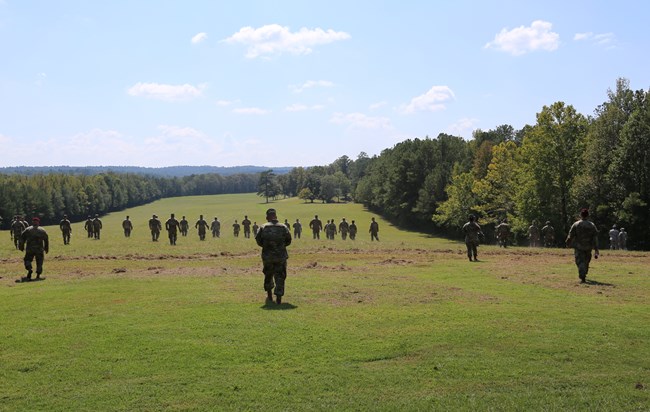
NPS Photo Horseshoe Bend National Military Park attracts more than 80,000 visitors each year from across the state, country, and even the world. Just as varied as their origins are the many reasons why people are attracted to rural east central Alabama and the park. Some visitors are history buffs seeking to stand on the ground that lay witness to the decisive battle of the Creek War, while others are drawn to the park’s natural beauty and its slow pace, which can act as a respite from a busy work week or a long car ride. Other individuals are “park collectors”, trying to visit every one of the 417 units in the National Park System that are spread across the 50 states and U.S. territories. Especially in the spring and summer, the park also receives school buses pulling into the lot; hives of Alabama fourth graders eager to see firsthand where the battle they’ve learned so much about took place. There is also yet another category of visitors that make up a significant portion of visitation at Horseshoe Bend that seems apropos given the park’s designation as a National Military Park. Two or three times a month, the park will be utilized by a class from a nearby military installation for a learning experience known as a staff ride. Staff rides began in the Prussian army in the latter half of the nineteenth century. The “staff” refers to the Great General Staff of the army which studied wartime tactics, plans, and mobilization. The staff would traverse on horseback certain locations that were thought to be of strategic significance if in fact war broke out in the future. In the early 1900s, the US Army transformed this classic staff ride. Instead of visiting sites that may possibly play a strategic role in a future war or battle, rides began to be conducted on the battlefields of the past. These past battles would be studied and discussed in detail in the classroom which then was followed by a visit to the actual battle site. The majority of these sites were the locations of significant American Civil War conflicts. In fact, one of the earliest U.S. Army staff rides took place in 1906 at Chickamauga and Chattanooga, the nation’s very first National Military Park. Rides today continue to follow the same general equation of classroom study combined with a site visit, and at Horseshoe Bend we also continue the tradition of staff rides in National Military Parks. Horseshoe Bend hosts about thirty staff rides a year. The participating classes come from several nearby military posts, including Fort Rucker (Dale County, AL), Fort Benning (near Columbus, GA), and Maxwell Air Force Base (Montgomery, AL), and are made up of military personnel from across the U.S. Other staff rides are comprised of students from state high school and college ROTC programs. Although the students and military personnel in these classes come from all over the country, their purpose seems to be universal; use the battlefield and the history preserved by the park as a tool to become better leaders. William Robertson, writing for the U.S. Army Center of Military History, touted the staff ride as “one of the most powerful instruments available for the professional development of U.S. Army leaders”. Although the weaponry and tactics of war have drastically changed from the time of the Battle of Horseshoe Bend (1814), there are important lessons to be learned by today’s military students. For the last two years, Chief Warrant Officer (CW4) Michael Johnson from the Warrant Officer Career College based at Fort Rucker has led staff rides at the park. “Staff rides at Horseshoe Bend allow students to discuss key points such as logistics, mission command, and coalition operations and how they were applied similarly in 1814 and today” says Johnson. “They also reinforce an interest in the heritage of the U.S. Army”. In January of this year, instructors from the LeMay Center for Doctrine Development, stationed at Maxwell AFB, took part in one of the class’s first staff rides at Horseshoe Bend. Their ride included a brief classroom component, a musket demonstration, and a battlefield walk focusing on leadership. “For me, walking the ground adds a personal element, gives me a brief glimpse into the past, and brings the stories of those who fought here to life,” remarked Jared, a participant and organizer of the ride. As an agency, the National Park Service strives to foster relevance of the special places it preserves in all citizens as well as visitors from around the globe. National parks are places of rejuvenation, recreation, education, and pure beauty. They preserve stories that can fill some with pride while simultaneously evoking senses of loss and sorrow in others. Whatever the feeling, parks like Horseshoe Bend help tie our past to our present, and hopefully will do so well into the future. Horseshoe Bend National Military Park is proud and eager to continue providing U.S. military men and women an opportunity to connect their roles as leaders in the 21st century to the decisive battle of the Creek War that occurred over 200 years ago. 
Christopher Adams |
Last updated: March 6, 2018
